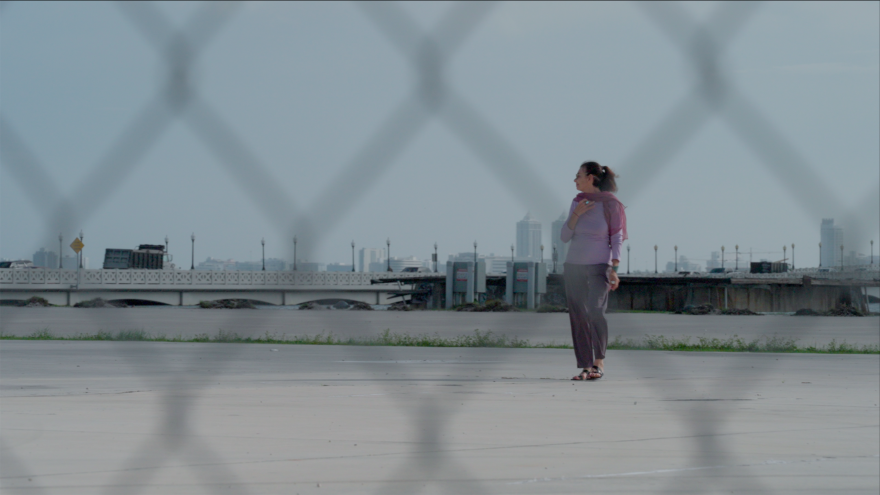Just over 10 years ago, One Herald Plaza, the building that was the Miami Herald's home for 50 years, was demolished. And with it, a piece of Miami's journalism history disappeared.
That loss inspired filmmaker Oana Martisca to explore how the news industry has changed, from the rise of the internet to the disappearance of physical newsrooms.
"What makes a newsroom important is we are surrounded by people who have that relationship of mentorship with us," Martisca said.
"And it's not just that we can learn by being in their vicinity, because of course that doesn't give us the tools to be who we are. But I think just running into people as they use the water cooler or at the elevator, you can come up with some idea about a story and it can just spark that inspiration."
Her documentary, News Without a Newsroom, uses archival footage from what the news industry used to look like in Miami and pairs it with interviews with several journalists and media experts to trace the shift of where media is heading.
The film premieres Friday, April 11 at 6:30 p.m. at the Cosford Cinema as part of the Miami Film Festival.
READ MORE: A historian will examine Florida's 'Lost Tourist Attractions,' including some Tampa-area landmarks
Originally from Romania, Martisca was a nonfiction writer and photojournalist before deciding to pursue a masters of fine arts in filmmaking at the University of Miami, in 2020.
" I've always had this sort of deep desire to find out more. It's in your DNA," she said.
She first heard about One Herald Plaza in a class at UM and decided to create a short documentary on it. After a grant from the Knight Foundation, Martisca was able to turn it into a full-length film.
WLRN's Jenny Jacoby sat down with Martisca to talk about why there's a need to understand how the journalism industry has changed.
This interview has been edited for clarity and brevity.

WLRN: You start the documentary with a really long sequence showing the Miami Herald in its prime, and then we kind of watch the Miami Herald a little bit fall apart. Why is the Miami Herald a perfect microcosm for what's happening with major newspapers in the country?
MARTISCA: I'm showing the golden age of the Miami Herald, representing not just the building that used to be, but also certain values and standards and the symbol of an institution that is collapsing.
It's not about the relationship with the building, it's the relationship with their colleagues. It's a space that is symbolically keeping an institution alive. The Miami Herald is just one of the papers that will suffer the same.
Can you tell me a little bit about crafting this story, choosing your sources to interview, and kind of telling the story almost from the inside while also working from this external perspective and talking to different members of the media, different outlets across the country?
So with documentaries, I think it's more than just storytelling, you kind of make a statement. People are usually not interested in just hearing information and data. They do not connect or relate so much to that. They're interested in human stories. So the way that I shaped this was going from one single story, it was Joey Flechas from the Miami Herald
Going from inside out, I thought it was important to cover the story on different levels. Because journalism was not affected just by the disappearance of newsrooms, there were different aspects that were affecting it and one was the disruption of the internet which changed the pace on how we're telling news and how we're consuming the news.
People generally understand that newspapers and the industry as a whole is struggling. How did you craft this documentary to explain that in a different or more compelling way to viewers?
For you and me who are more familiar with the news, I would say it's common sense and that we would expect that people are familiar with what is happening to the newspaper industry. However, I don't know if that awareness is actually brought so widely. I've met many people who have lived here for years and were not aware of what happened with the Miami Herald building. I don't think they're aware of how much the journalists are struggling.
Why is it important for people to confront the reality of present day journalism?
I think it's important for students and readers of all ages to look at who is going to represent them and feel safe to go towards journalists and reestablish that conversation where they can feel represented and their voice is represented in our communities. And I think part of that is what the local nonprofit model is trying to rebuild, the trust in media, the trust in journalists and to have that sort of relationship with them that has over time eroded.
You are wrapping up your master in fine arts at the University of Miami, and this film actually gets to premiere at the University of Miami in the Cosford Cinema. What does it mean to you to see something that you've been working on for the past two years and that represents so much of your time and effort?
It's finally starting to feel real and the fact that it's becoming so much more meaningful than when I began. It's taking shape into a statement, a message. I feel and I hope it will inspire other students to do the same.
Keep up with South Florida's arts and culture scene by signing up for The A/C Newsletter. Every Wednesday, the A/C will offer a curation of stories and deep dives that celebrate South Florida's arts community. Click here to subscribe.
Copyright 2025 WLRN Public Media



